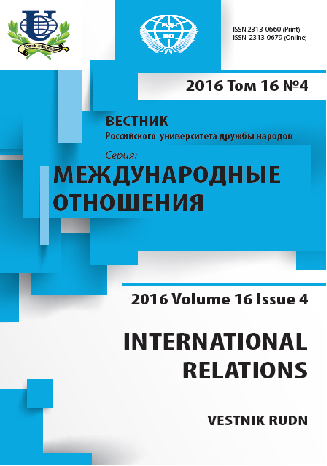The “Arabian Axis” in Kuwait Crisis: background and process of formation
- Authors: Rodriguez-Fernandez A.M.1
-
Affiliations:
- Moscow State Pedagogical University
- Issue: Vol 16, No 4 (2016): Iran and India in the System of International Relations
- Pages: 726-735
- Section: Articles
- URL: https://journals.rudn.ru/international-relations/article/view/15445
- DOI: https://doi.org/10.22363/2313-0660-2016-16-4-726-735
Cite item
Full Text
Abstract
The formation of the «Arabian Axis» in the number of state coalition opposing the aggression of Saddam Hussein in Kuwait (1990-1991) is regarded in the article. Research methodology is based on the principles of four types of scientific knowledge: general scientific, historical, socio-scientific and problematic. The historical method, which is fundamental for the author, was used as a basis research approach to the phenomena formation and development, as well as the organic coherence of these facts and the conditions causing them. In the frame of this article author analyzes the causes, conditions of formation of “anti-Iraqi triangle” of Saudi Arabia - Egypt - Syria. The author concludes that the three members of the “Arab Axis” had many reasons to fear a dominant role and aggression of Iraq. In particular, in Syria S. Hussein confronted H. Assad, and Assad’s participation in the anti-Saddam coalition was completely predictable. Egyptian President Hosni Mubarak believed that the interests of his country will be threatened if Iraq starts to dominate the Middle East arena. Saddam Hussein was also potentially dangerous for the Saudi kingdom, because he considered himself the winner in the war with Iran.
Keywords
About the authors
Aleksandr Manuelevich Rodriguez-Fernandez
Moscow State Pedagogical University
Author for correspondence.
Email: amrodriges@mail.ru
Moscow, Russia
References
- Abir, M. (1994). Saudi Arabia. Government Society and the Gulf Crisis. N.Y.
- Aleksandrov, I.A. (2000). Monarkhii Persidskogo Zaliva: etap modernizatsii [Gulf monarchies: stage of modernization]. Moscow.
- Al’-Dimkkhi, A.M. (1998). Saddam Khusein. Mamlyakatu l’-fazin fi. Kuveit.
- Ar-Rashud, F. (1999). Kuveit khatta va baada l’-asika. Dimashk. Arabia after the Storm. (1992). London. Arabia.
- The Gulf and the West. (1998). London.
- Boulder, A.H. (1993). After the Storm. The Changing Military Balance in the Middle East.London.
- Derbenev, A.S. (2014). Neftyanoi faktor v politike SShA v otnoshenii Saudovskoi Aravii i anglo-amerikanskoe neftyanoe soglashenie 1944 goda [Oil factor in US policy toward Saudi Arabia and the Anglo-American Oil Agreement 1944]. Novaya i noveishaya istoriya, 1.
- Dilip, H. (1999). Desert Shield to Desert Storm. N.Y.
- Helms, K. (1999). The Persian Gulf. Power in the Post. Cold War. N.Y. Khaled, Sultan. (1996). Voin pustyni. Moscow.
- Melkumyan, E.S. (1989). Kuveit v 60—80-e gody. Sotsial’no-ekonomicheskie protsessy i vnesh-nyaya politika [Kuwait in the 60—80 years. Socio-economic developments and foreign policy]. Moscow. Primakov, E.M. (2006). Konfidentsial’no: Blizhnii Vostok na stsene i za kulisami [Confidential: The Middle East on stage and behind the scenes]. Moscow.
- Rodriges, A.M. (2000). Araviiskie monarkhii v XX veke: ekonomika, politika, sotsial’naya struktura [Arabian monarchy in the XX century: economics, politics, social structure]. Lewiston, N.Y.
- Rodriges, A.M. (2005). Kuveit, Irak i mirovoe soobshchestvo v kontse XX v.: retrospektiva i po-sledstviya «Krizisa v Zalive» 1990—1991 godov [Kuwait, Iraq and the international community at the end of XX century: retrospective and consequences of the “Gulf crisis” of 1990—1991]. Moscow.
- Vasil’ev, A.M. (1988). Istoriya saudovskoi Aravii [History of Saudi Arabia]. Moscow.











